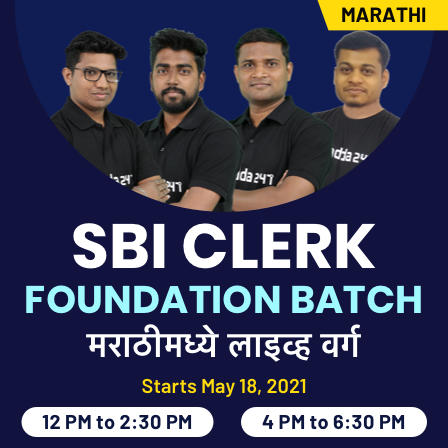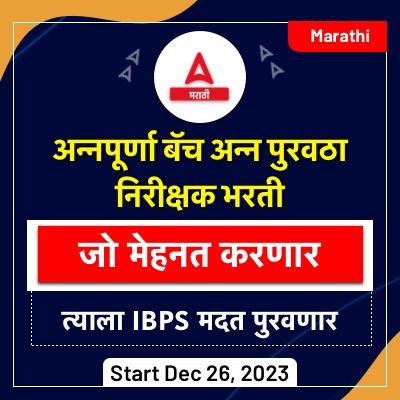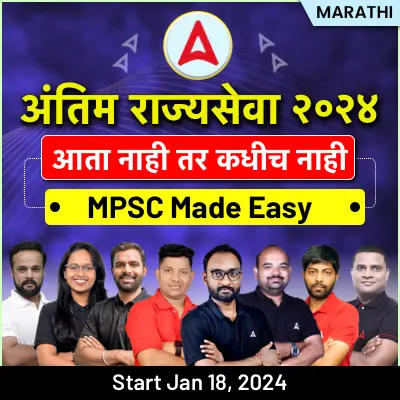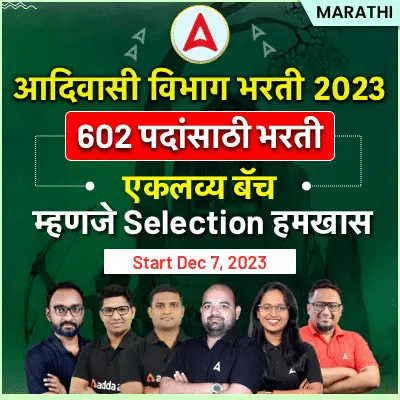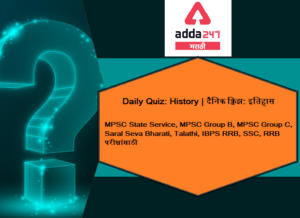
इतिहास दैनिक क्विझ मराठीमध्ये: 22 मे 2021
महाराष्ट्र राज्य लोकसेवा आयोग दरवर्षी वेगवेगळ्या परीक्षे मार्फत हजारो विद्यार्थ्यांची भरती करून घेते MPSC State Service, MPSC Group B, MPSC Group C, Saral Seva Bharati, Talathi, UPSC, SSC, RRB अशा अनेक परीक्षांमार्फत हजारो जागांची भरती दरवर्षी निघते ज्यात लाखो इच्छुक हजार किंवा त्याहूनही कमी जागांसाठी अर्ज करतात. आपण एमपीएससी आणि इतर परीक्षाची तयारी करत असाल तर आपल्याला क्विझ देण्याचे महत्त्व माहित असलेच पाहिजे. बर्याच विद्यार्थ्यांना अभ्यासाचे पुरेसे तास दिले जात असतानाही त्यांना या परीक्षांची पूर्तताही करता आली नाही कारण ते त्यांचे परीक्षण वेळेवर पूर्ण करू शकत नाहीत आणि संशोधन करण्याचा उत्तम मार्ग म्हणजे त्या संबंधित विषयाची किंवा विषयाची क्विझ देणे कारण आपण या मार्गाने कव्हर करू शकता कमी वेळात जास्तीत जास्त विषय. आम्हाला Add 247 मराठी येथे चांगल्या अभ्यास सामग्रीचे मूल्य समजले आहे आणि म्हणूनच आम्ही सर्व विषयांसाठी आपल्याला क्विझ प्रदान करीत आहोत. दैनिक क्विझ देऊन तुम्ही तुमच्या तयारीची पातळी तपासू शकता.
चालू घडामोडी, भूगोल, अर्थशास्त्र, पर्यावरण, सामान्य विज्ञान, इतिहास, पॉलिटी अशा सर्व स्पर्धात्मक सामान्य अभ्यास विषयांमध्ये इतिहासाचाही महत्वाचा वाटा आहे. तर चला इतिहास बद्दल तुमची तयारी तपासण्यासाठी खालील 22 मे 2021 ची इतिहासाची दैनिक क्विझ पहा.
Q1. इल्बर्ट बिलचे उद्दीष्ट होते
(a) भारतीयांकडून शस्त्रे बाळगण्यासाठी काही निर्बंध लादणे
(b) भारतीय भाषांमध्ये प्रकाशित होणारी वर्तमानपत्रे आणि मासिकेंवर निर्बंध आणा
(c) युरोपियन लोकांच्या खटल्यासंदर्भात भारतीय दंडाधिकाऱ्यांना लादलेल्या अपात्रते दूर करा
(d) आयातित कच्च्या रेशीमवरील शुल्क काढा
Q2. खाली मध्ययुगीन काळात लढाई आणि त्या युद्धात विजय मिळविणारा शासक याची यादी केली आहे. चुकीची
जोडी शोधा
(a) खानुआची लढाई – बाबर
(b) धर्माची लढाई – औरंगाजेब
(c) कानौजची लढाई – हुमायूं
(d) चौसाची लढाई – शेरशाह
Q3. भारत सरकार अधिनियम, 1935 मध्ये याची तरतूद आहेः
1. प्रांतीय स्वायत्तता
2. फेडरल कोर्टाची स्थापना
वरीलपैकी कोणते विधान बरोबर आहे?
(a) फक्त 1
(b) फक्त 2
(c) दोन्ही 1 आणि 2
(d) 1 किंवा 2 देखील नाही
Q4. पुढील विधानांचा विचार करा
1. चौथ हे वार्षिक कर होते ज्यात महसूल किंवा उत्पन्नावर 60% दराने आकारले जाते,
2. सरदेशमुखी चौथच्या वर 10% अतिरिक्त आकारणी होती.
वरीलपैकी कोणते विधान बरोबर आहे/ आहेत?
(a) फक्त 1
(b) फक्त 2
(c) दोन्ही 1 आणि 2
(d) 1 किंवा 2 देखील नाही
Q5. भारतीय स्वातंत्र्यलढ्याच्या संदर्भात सूर्य सेनशी संबंधित?
(a) गदार चळवळ
(b) काकोरी षडयंत्र
(c) 1928 मध्ये बॉम्बे टेक्सटाईल गिरण्यांचा संप
(d) चितगाव शिलेखाना हल्ला
Q6. रिंग-फेंस पॉलिसी संबंधित खालील विधानांचा विचार करा
1. कंपनीच्या फ्रंटियर्सचा बचाव करण्यासाठी हे बफर झोन तयार करण्याचे उद्दीष्ट आहे
2. अशाप्रकारे रिंग-फेंस सिस्टम अंतर्गत आणलेल्या राज्यांना बाह्य आक्रमणाविरूद्ध स्वतःच्या खर्चाने लष्करी मदतीचे आश्वासन देण्यात आले होते.
वरीलपैकी कोणते विधान बरोबर आहे/ आहेत?
(a) फक्त 1
(b) फक्त 2
(c) दोन्ही 1 आणि 2
(d) 1 किंवा 2 देखील नाही
Q7. पुढील विधानांचा विचार करा
1. बल्गानच्या कारकिर्दीत चेंगीझ खानच्या अधीन मंगोल्यांनी भारतावर आक्रमण केले
2. चेंगीझ खानच्या सैन्याने गंगा यमुना डोआब लुटला आणि मोठ्या प्रमाणात जीवित व मालमत्तेचे नुकसान केले.
वरीलपैकी कोणते विधान बरोबर आहे/ आहेत?
(a) फक्त 1
(b) फक्त 2
(c) दोन्ही 1 आणि 2
(d) 1 किंवा 2 देखील नाही
Q8. सहाय्यक आघाडीबाबत खालील विधानांचा विचार करा
1. या संरक्षण जाळ्यात कोसळणारे पहिले भारतीय राज्य सातारा हे होते
2. युरोपियन सैन्याने भाड्याने युरोपातील सैनिकांना युद्धात लढायला दिले होते
3. सहाय्यक आघाडी स्वीकारणार्या राज्याला परराष्ट्र संबंध ठेवण्याची परवानगी होती
वर दिलेली कोणती विधाने बरोबर आहे / आहेत?
(a) 1 आणि 2
(b) 2 आणि 3
(c) 1 आणि 3
(d) 1, 2 आणि 3
Q9. पुढीलपैकी कोणत्या शासकाने सहाय्यक आघाडी स्वीकारली
(a) तंजोर शासक
(b) हैदराबादचा निजाम
(c) होळकर
(d) राजपूत जोधपूरची राज्ये
योग्य कोड निवडा:
(a) 1,2,3
(b) 2,3,4
(c) 1,3,4
(d) 1,2,3,4
Q10. लॅप्सेच्या सिद्धांताविषयी खालील विधानांचा विचार करा
1. ही शिकवण हिंदू नियमांवर आधारित असल्याचे सांगितले गेले होते परंतु भारतीय प्रथानुसार नाही
2. महाराज रणजित सिंह हे एकमेव शासक होते ज्यांनी संपत्तीच्या कारणास्तव आपल्या सरंजामशाहींना जोडले नाही म्हणजेच वारसा म्हणून सोडले नाही
वरीलपैकी कोणते विधान बरोबर आहे/ आहेत?
(a) फक्त 1
(b) फक्त 2
(c) दोन्ही 1 आणि 2
(d) 1 किंवा 2 देखील नाही
Solutions
S1.Ans.(c)
Sol.
S2.Ans.(c)
Sol.
http://khadc.nic.in/acts_rules_regulations_bills/The%20Government%20of%20India%20Act,%201935.pdf
https://www.constitutionofindia.net/historical_constitutions/government_of_india_act_1935_2nd%20August%201935
S3.Ans.(c)
Sol.
In the Battle of kanauj (1540), Humayun was defeated by Shershah
S4.Ans.(b)
Sol.
Chauth and Sardeshmukhi were taxes conceived during the times of the Great Maratha Ruler Shivaji Maharaj.
Chauth’ means basically 1/4th i.e 25% of gross revenue or produce to be paid to jagirdars of Maratha empire from the hostile or alien state ( and not on peasants in Maratha empire). In return, the state paying the tax would get an assurance of nonaggression from the Maratha army against the enemy state.
‘Sardeshmukhi’ is an additional 10% tax levied upon the collected ‘Chauth’. The reasons for the additional tax were due to the King claiming hereditary rights upon the tax collection. The Sardeshmuki directly went to the King’s treasury whereas the share of the king in Chauth was 1/3rd of the gross Chauth collected.
S5.Ans.(d)
Sol.
Surya Sen soon gathered around himself a large band of revolutionary youth including Anant Singh, Ganesh Ghosh, and Lokenath Baul. They decided to organize a rebellion, on a however small scale, to demonstrate that it was possible to challenge the armed might of the British in India. Their action plan was to include occupation of the two main armories in
Chittagong and seizing of their arms with which a large band of revolutionaries could be formed into an armed detachment; the destruction of the telephone and telegraph system of the city; and the dislocation of the railway communication system between
Chittagong and the rest of Bengal. The action was carefully planned and put into execution at 10 o’clock on the night of 18 April 1930.
S6.Ans.(c)
Sol.
Warren Hastings took charge as the governor-general at a critical period of British rule when the British were to
S7.Ans.(d)
Sol.
The threat appeared at the time of Itutmish. He avoided their threat by politely refusing the asylum request of Jalaluddin, who the Mongol army was after. Thus India was saved from Chenghiz invasion. Chenghiz loitered near River Indus for 3 months but decided not to cross into India.
S8.Ans.(a)
Sol.
It was probably Dupleix, who first gave on hire (so to say) European troops to Indian rulers to fight their wars. Since then, almost all the governors-general from Clive onwards applied the system to various Indian states and brought it to near perfection. The first Indian state to fall into this protection trap (which anticipated the subsidiary alliance system) was Awadh which in 1765 signed a treaty under which the Company pledged to defend the frontiers of Awadh on the condition of the Nawab defraying the expenses of such defense. It was in 1787 that the Company first insisted that the subsidiary state should not have foreign relations. This was included in the treaty with the Nawab of Carnatic which Cornwallis signed in February 1787.
S9.Ans.(d)
Sol.
States which Accepted Alliance The Indian princes who accepted the subsidiary system were: the Nizam of Hyderabad (September 1798 and 1800), the ruler of Mysore (1799), the ruler of Tanjore (October 1799), the Nawab of Awadh (November 1801), the Peshwa (December 1801), the Bhonsle Raja of Berar (December 1803), the Sindhia (February 1804), the Rajput states of Jodhpur, Jaipur, Macheri, Bundi and the ruler of Bharatpur (1818). The Holkars were the last Maratha confederation to accept the Subsidiary Alliance in 1818.
S10.Ans.(d)
Sol.
the doctrine stated that the adopted son could be the heir to his foster father’s private property, but not the state; it was for the paramount power (the British) to decide whether to bestow the state on the adopted son or to annex it. The doctrine was stated to be based on Hindu law and Indian customs, but Hindu law seemed to be somewhat inconclusive on this point, and the instances of an Indian sovereign annexing the state of his vassal on account of ‘lapse’ (i.e., leaving no issue as heir) were rather rare. Maharaja Ranjit Singh had annexed a few of his feudatory principalities on account of ‘lapse’. Likewise, the Company in 1820 acquired a few petty Cis-Sutlej states in the absence of heirs. Nonetheless, there was no clear-cut instance of an adopted son being deprived of an entire state or of such a state being regarded as a ‘lapse


